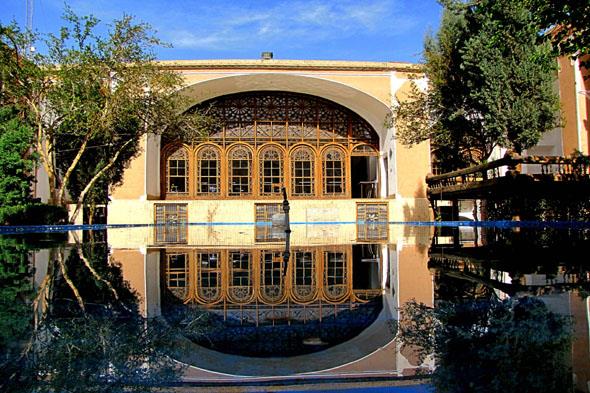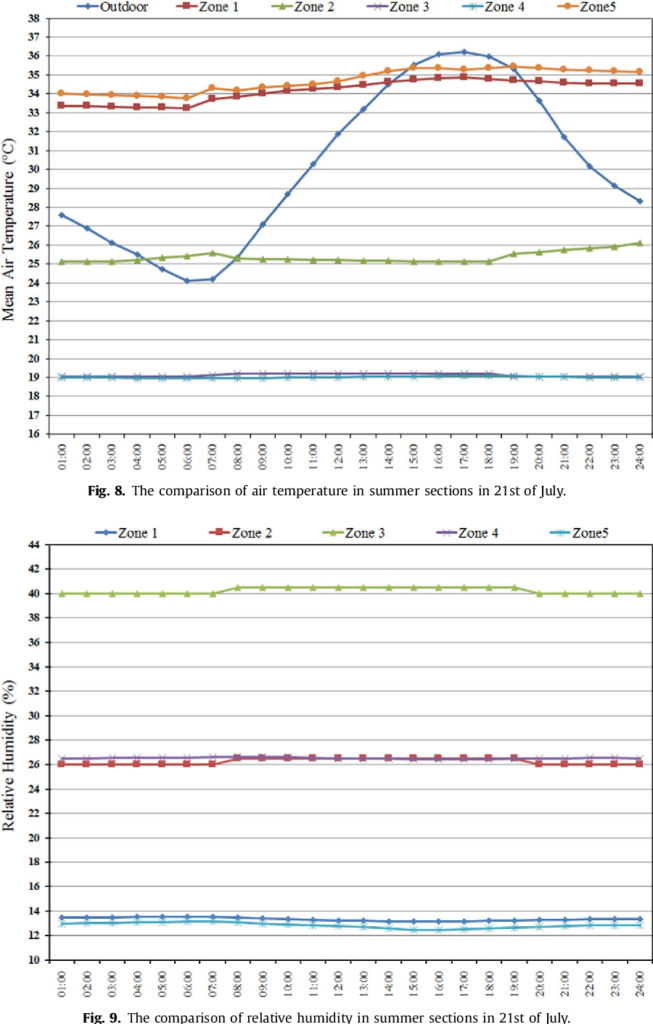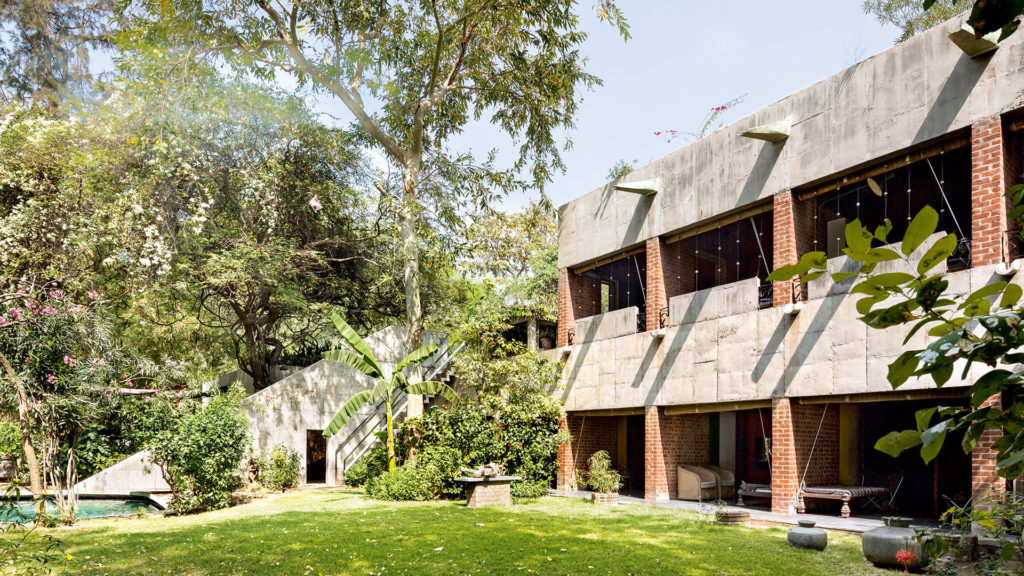Definition
The link between thermal pleasure and thermal acceptability is referred to as alliesthesia. It implies that adaptability, asymmetries, and transient conditions are among the subjective variables that affect people’s perceptions of thermal comfort in addition to objective parameters like temperature, humidity, and air velocity. The design and assessment of thermal comfort in buildings and other enclosed areas are significantly impacted by this idea. Researchers and professionals can better understand and predict human thermal behavior and preferences in various contexts and comfort systems by taking into account the role of alliesthesia in thermal perception. This report seeks to give a general review of the present level of understanding on alliesthesia and its importance to the study of and application in the field of thermal comfort.
“Alliesthesia can be defined as the change to a sensory experience that can be perceived as positive or negative. It applies to all senses which help define the broader definition of indoor environmental quality. Proponents of adaptive thermal comfort and naturally ventilated spaces use alliesthesia to draw attention to the benefits from exercising ones thermal regulatory systems.”(Health & Well-Being through Architecture, Building Science & HVAC Design, Robert Bean).
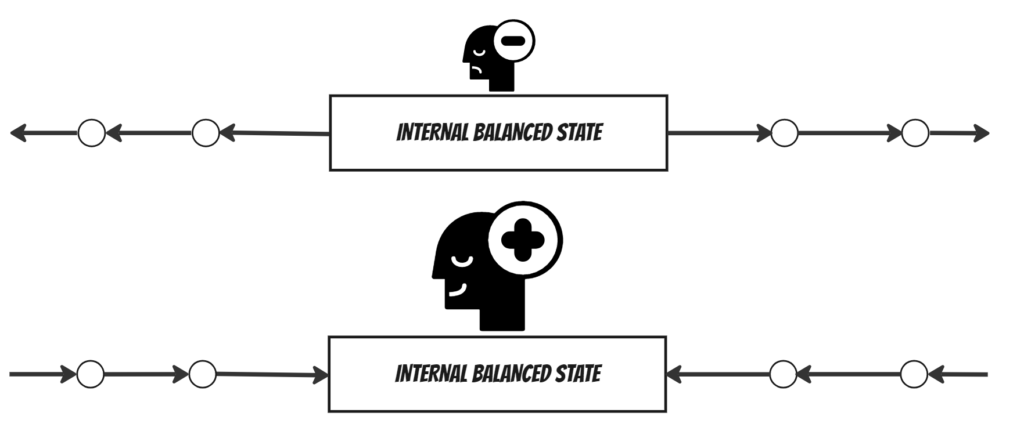
While returning to our core balance, we experience pleasure. The further away we are from the balanced body’s core balance, the more discomfort we experience.
Subconscious Evaluation of Alliesthesia
Valence in Architecture
For humans that are not aware of the spatial qualities, basic affective reactions—unconscious emotional responses that can alter behavior and interact with motivation—are a topic covered in the technical paper [Winkielman, P., Berridge, K. C., & Wilbarger, J. L. (2005). Unconscious Affective Reactions to Masked Happy Versus Angry Faces Influence Consumption Behavior and Judgments of Value. Personality and Social Psychology Bulletin, 31(1), 121–135. https://doi.org/10.1177/0146167204271309.]
To research these qualities, the writers ran a number of studies. In the first experiment, scientists showed individuals subliminally joyful or furious faces and watched what happened to how they poured and drank an unknown beverage. They discovered that subliminal frowns had the opposite impact from subliminal smiles, making thirsty participants pour and drink more. In the second study, which examined the impact of affective primes on the perception of beverage value, it was discovered that subliminal smiles enhanced participants’ willingness to pay and demand for further beverages, whereas subliminal frowns had the reverse effect on thirsty participants. The findings imply that fundamental affective responses can interact with incentive motivation in an unconscious manner to affect behavior toward valenced items and value judgments.

The validity of a measurement based on a subjective report is debatable, yet valence might be given a number and treated as if it were measured. The affective characteristic pertaining to the inherent appeal or unattractiveness of an occasion, thing, or circumstance is valence, or hedonic tone. Additionally, the phrase describes and groups particular feelings. For instance, emotions like wrath and fear that are frequently referred to as “negative” have a negative valence. Joy has a good energy. Positively valenced situations, things, or events cause positive feelings to be triggered. Additionally, the phrase is used to characterize the hedonistic undertone of emotions, affect, certain behaviors (such as approach and avoidance), goal success or nonachievement, and conformance to or contravention of norms. Conflict between positive and negative valence-carriers might be seen as the root of ambivalence.

Source:https://dragallery.tumblr.com/post/54772342965/obscuring-the-highlights-an-interview-with
Conscious Evaluation of Alliesthesia
Spatial Awareness
In juxtaposition to the aforementioned this section will try to embrace the individuals throughout history that are acknowledging spatial importance and alliesthesia. Juhani Pallasmaa, a Finnish architect and theorist, wrote “The Eyes of the Skin: Architecture and the Senses,” which was published in 1996. The book is a collection of essays that examines how our perception of the built environment is shaped by our senses and their role in architecture. The notion that building should be created with all senses in mind, not only sight, is one of the book’s central topics. The dominance of the visual sense in contemporary architecture, according to Pallasmaa, has resulted in a disregard of the other senses, which can lead to a limited and insufficient understanding of the built world. The idea of haptic perception—which relates to the sensation of touch and how it affects how we perceive the built environment—is also covered by Pallasmaa. He contends that the sense of touch and the sense of space are strongly related, and that the texture, warmth, and other physical characteristics of a building can greatly influence how we perceive it. Pallasmaa examines how the senses of hearing, smell, and taste relate to architecture in addition to sight and touch. He contends that although these senses are frequently disregarded in contemporary architecture, they can be crucial in establishing a building’s sense of location and identity. In this work the author investigates potential alliesthesia sensations with quotes as such:
- When entering the magnificent outdoor space of Louis Kahn’s Salk Institute in La Jolla, California, I felt an irresistible temptation to walk directly to the concrete wall and touch the velvety smoothness and temperature of its skin.
- Our skin traces temperature spaces with unerring precision; the cool and invigorating shadow under a tree, or the caressing sphere of warmth in a spot of sun, turn into experiences of space and place
- Standing barefoot on a smooth glacial rock by the sea at sunset, and sensing the warmth of the sun-heated stone through one’s soles, is an extraordinarily healing experience, making one part of the eternal cycle of nature. One senses the slow breathing of the earth.
- Many years ago when visiting the DL James House in Carmel, California, designed by Charles and Henry Greene, I felt compelled to kneel and touch the delicately shining white marble threshold of the front door with my tongue.
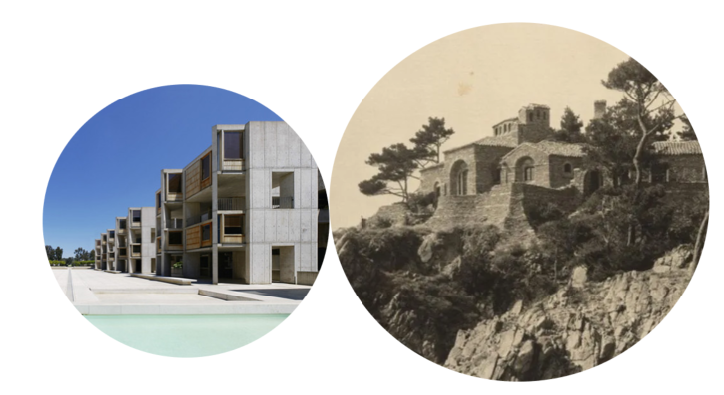
Source:https://www.artsy.net/artwork/louis-kahn-salk-institute-for-biological-studies-model, https://gamblehouse.org/james-house/
The idea that architecture should be more than just a sensory perception experience is one of the book’s key points. Pallasmaa thinks that for an experience to be fully immersive and meaningful, architecture should appeal to all of the senses. He contends that a limited and insufficient understanding of the built environment has resulted from modern architecture’s neglect of the other senses.
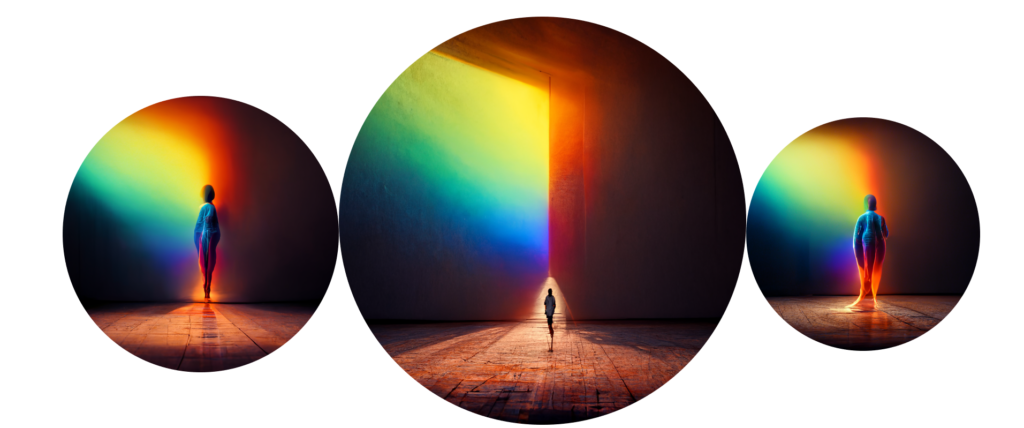
Source:https://cdn.midjourney.com/7bc774cd-a212-41a0-964f-e659794f0ed8/grid_0.png
Pallasmaa continuous with mentions regarding the spatial awareness qualities and with him it is profound that alliesthesia is actively existent. Before any conscious examination of specifics is undertaken, the atmospheric qualities of locations, situations, and settings are comprehended. Despite its evident significance, atmospheric perception has seldom ever been discussed in relation to architecture. According to neurological research, rather than the other way around, our processes of perception and cognition move from the instantaneous grasp of entities to the identification of details.

Source:https://www.caravaggio.org/the-incredulity-of-saint-thomas.jsp https://www.renemagritte.org/the-lovers-1.jsp https://aeon.co/essays/how-gaston-bachelard-gave-the-emotions-of-home-a-philosophy https://www.blindarte.com/home/cataloglot/4221
Another example throughout history and into divergent fields of art, the references of alliesthesia are profound as illustrated in the pictures above “Regardless of our prioritization of the eye, visual observation is often confirmed by our touch” Caravaggio, The Incredulity of Saint Thomas, “In heightened emotional states and deep thought, vision is usually repressed.” René Magritte, The Lovers, “There is a strong identity between naked skin and the sensation of home. The experience of home is essentially an experience of intimate warmth. The space of warmth around a fireplace is the space of ultimate intimacy and comfort.” Gaston Bachelard, “It is like an immaterial alcove, a warm cave carved into the room itself, a zone of hot weather with floating boundaries, Marcel Proust.
To conclude the entire universe is reduced to a meaningless, hedonistic visual experience. It is obvious that only the detached and distanced sense of vision is capable of a nihilistic mindset; for example, it is hard to imagine a nihilistic sense of touch due to the sense of touch’s inherent closeness, intimacy, authenticity, and identity. Numerous civilizations are described in anthropological literature as having a strong reliance on their own senses of smell, taste, and touch for behavior and communication. As mentioned in, “The Hidden Dimension” , a significant work by Edward T. Hall, that was about the roles of the senses in how people use communal and private space in different cultures.

“The recollection brings back the lovely city with all of its noises, scents, and differences in light and shadow. In the delightful metropolis of my memories,” Juhani Pallasmaa.
Source:https://cdn.midjourney.com/fa31fd25-9a55-4745-b2c5-65a04b82d0fa/grid_0.png
The temperature of emotions
People appear to correlate temperature notions with emotions, and emotions and temperature are tightly associated through embodied processes. Although this association is frequently demonstrated in language used in everyday life (e.g., chilly and warm sentiments), comprehensive research that examines how and why individuals link certain temperatures to emotions has not yet been done.
Experiment 1
The objective of the current study as cited [Barbosa Escobar F, Velasco C, Motoki K, Byrne DV, Wang QJ (2021) The temperature of emotions. PLoS ONE 16(6): e0252408. https://doi.org/10.1371/journal.pone.0252408] was to examine the relationships between explicit and implicit emotional states and temperature ideas. In Experiment 1, the researchers assessed the explicit relationships between 12 pairs of emotion descriptors and five distinct temperature ideas (range from 0 to 40 degrees Celsius). The findings of this study revealed that several parts of the circumplex model of affect were connected with temperature notions across languages. For instance, negative valenced, low-arousal emotions were connected with 0 and 10 degrees Celsius, but positive valenced, low-to-medium arousal emotions were associated with 20 degrees Celsius. By using native English speakers for Unconscious Association Tests, the researchers in Experiment 2 determined if these temperature-emotion correlations existed at the implicit level as well.
Analytically, 451 people participated in an online experiment where they were asked to rate the accuracy with which various emotion terms matched various temperature notions. The participants were chosen from a pool of applicants using a combination of internet resources and the authors’ personal and professional networks, and they were required to respond to the questionnaire in the language of their choice. The final data set includes observations from 403 individuals who spoke English, Spanish, Japanese, and Chinese and came from 28 different countries. Twelve pairs of adjectives were used as the emotion stimuli, each representing a distinct level of valence and arousal on the circumplex model of affect. On a scale from “Not at all” to “Extremely well,” the participants were asked to judge how well each of these feelings matched each of five distinct temperature notions.
According to the experiment’s findings, participants implicitly associated the words “hot” and “cold” with positive-valenced, high-arousal feelings and negative-valenced, low-arousal emotions, respectively. These data demonstrate the presence of temperature-emotion relationships across languages, both explicitly and implicitly.
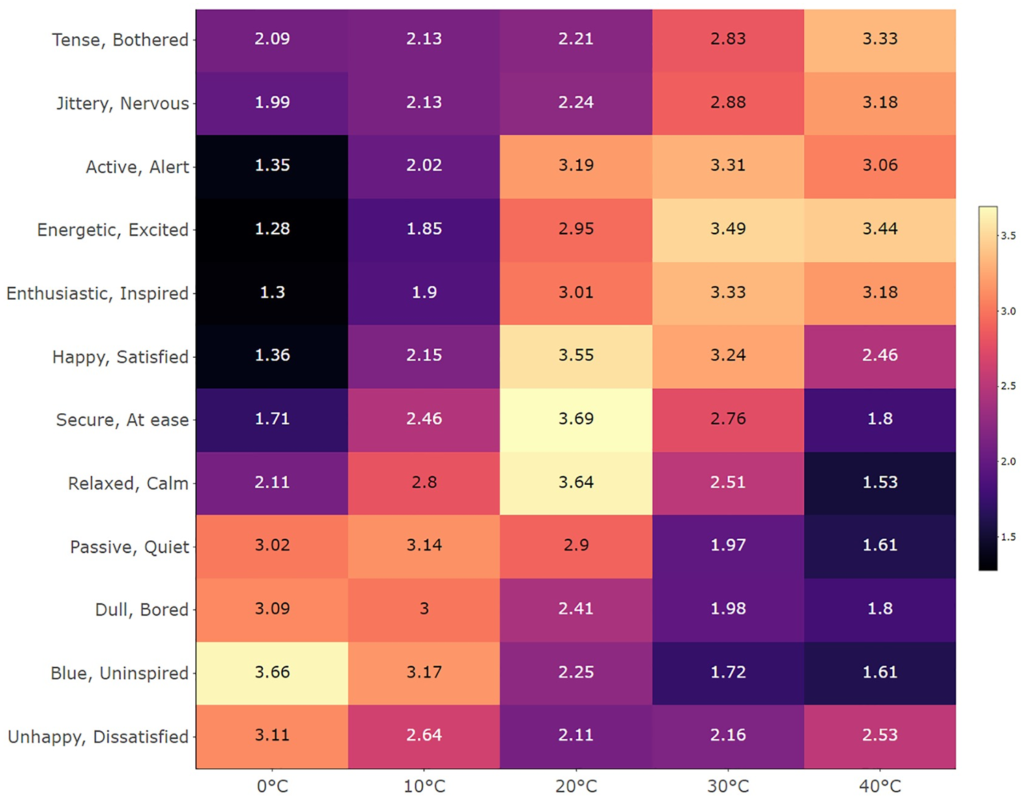
Source:https://www.ncbi.nlm.nih.gov/pmc/articles/PMC8174739/
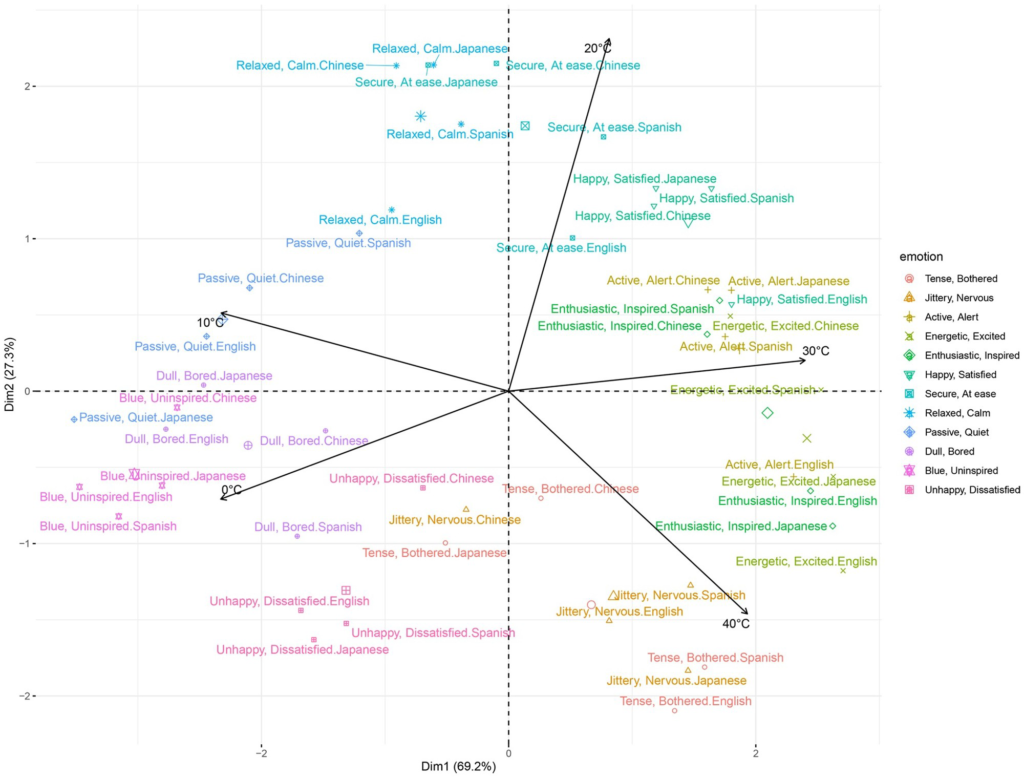
Source:https://www.ncbi.nlm.nih.gov/pmc/articles/PMC8174739/
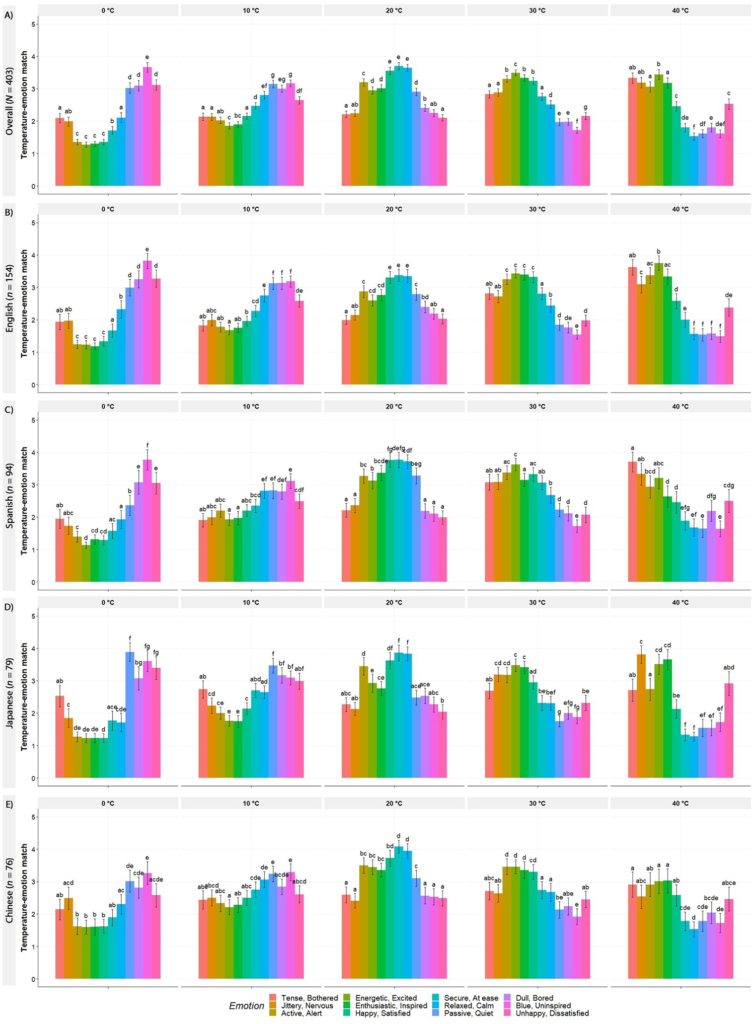
Source:https://www.ncbi.nlm.nih.gov/pmc/articles/PMC8174739/
The paper interprets the results as:
” The PCA revealed that the first two dimensions explained 96.53% of the variance in the data, where the first principal component (PC1) accounted for 69.20%, and the second principal component (PC2) accounted for 27.33% (the corresponding factor loadings are presented. Given these results, it seems as if the first and second dimensions described arousal and valence, respectively. In the PCA projection, increasing temperatures moved clockwise starting with 0 ?C in the third quadrant and ending with 40 ?C in the fourth quadrant.”
“Mean temperature association ratings following Model 1 of the linear mixed model (LMM) analysis using temperature as a continuous variable. The emotion adjectives appear in the x-axis, and the languages are color-coded. The error bars represent the confidence intervals.”
“The y-axis is on a 1–5 scale, where 1 indicates the emotion and the temperature do not match well at all, and 5 indicates they match very well. The plots are divided into different blocks for each temperature (horizontally) within each language (vertically). The error bars represent the standard errors of the mean. The letters represent the different significance groups (p < .05) within each temperature and language as per the Wilcoxon Signed Rank Test.”
Results
In Experiment 1, the researchers assessed the degree to which the general public connected various emotion terms with specific temperature ideas. The greatest mean associations ratings were observed to shift from the bottom left side of the valence-arousal emotion circumplex, which reflects negatively valanced, low arousal emotions, to the upper left side as temperature rose (which represents positively valanced, high arousal emotions). In the moderate range, greater temperature ideas were linked to words that expressed emotions more favorably. Extreme cold and hot temperature ideas (0 and 40 degrees Celsius) were linked to emotion adjectives with a negative valence, whereas 40 degrees Celsius was also linked to an emotion adjective with a positive valence. The results demonstrated a linear association between ideas with greater temperature and adjectives with high emotional arousal.
Experiment 2
Onward with the second phase, the purpose of Experiment 2 was to determine if the relationships between temperature and emotion descriptors found in Experiment 1 were also present at the implicit level. To do this, they used temperature words (hot and cold) and emotion descriptors that varied in valence (unhappy/dissatisfied vs. happy/satisfied) and arousal (passive/quiet vs. active/alert) in Implicit Association Tests (IATs) with native English speakers. According to the IAT results, participants responded more quickly to the word hot when it was associated with positive-valence and high-arousal emotion words than when they were matched with the word cold. This implies that the words hot and positive-valence, high-arousal emotions have implicit links, but cold and negative-valence, low-arousal emotions do not.
Overall, the findings of Experiment 1 and Experiment 2 are consistent with the hypothesis that there are explicit and implicit links between temperature ideas and emotion adjectives. The relationships between temperature terms and certain areas of the circumplex model of core impact as temperature rises appear to be quite constant across languages. For instance, in Experiment 1, negative-valence and low-arousal emotions were related with temperatures of 0 and 0 degrees Celsius, respectively, whereas positive- or negative-valence emotions were associated with temperatures of 40 and 40 degrees Celsius, respectively.
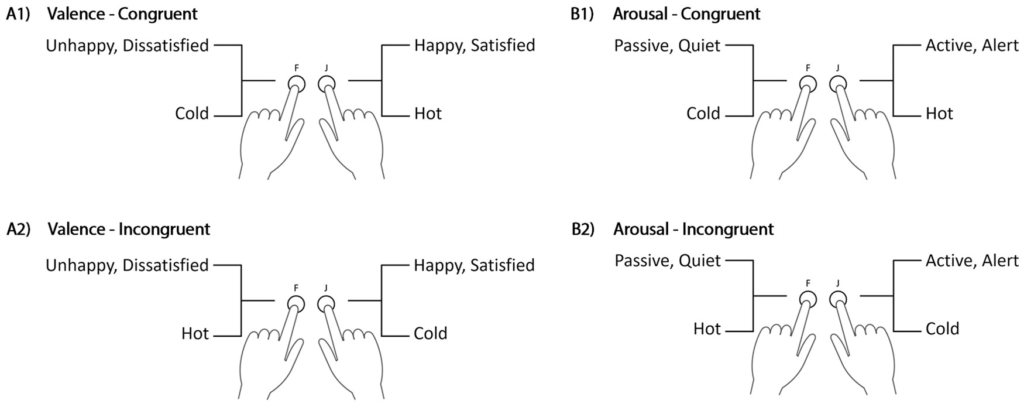
Assignments in the valence dimension are on the left-hand side (A1, A2), while the arousal dimension is on the right-hand side (B1, B2). The upper panels display assignments that are consistent, whereas the lower panels display assignments that are inconsistent.
Source:https://www.ncbi.nlm.nih.gov/pmc/articles/PMC8174739/
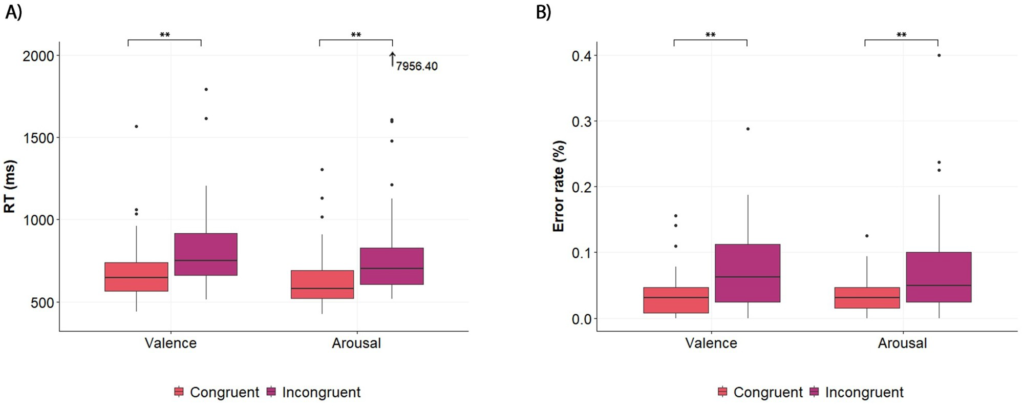
Source:https://www.ncbi.nlm.nih.gov/pmc/articles/PMC8174739/
Results
The findings of Experiment 2 showed that when heat was paired with positive-valence and high-arousal emotion words and cold was paired with negative-valence and low-arousal emotion phrases, participants responded more quickly. Overall, the findings of the two studies showed that temperature concepts and emotion adjectives had both explicit and implicit relationships. The findings also showed an inverse U-shaped relationship between temperature concepts and valence, with mild ambient temperatures being associated with positive valanced emotions and extreme temperatures being associated with negative valanced emotions. There was also a positive relationship between temperature concepts and the arousal dimension of emotions.
Creating alliesthesia in cool environments using personal comfort systems
Experiment carried by: YingdongHe ThomasParkinson EdwardArens HuiZhang NianpingLi JinqingPeng JohnElso ClayMaranville, 1st February 2022
The purpose of this study is to determine whether Personal Comfort Systems (PCS) can improve occupant alliesthesia while lowering the energy required to condition indoor environments. The findings of this experiment will be crucial in evaluating various indoor conditioning systems in order to replace conventional HVAC and PMV parameters with a more direct control of an enclosed space’s thermal conditions.
Setting
Twenty subjects experienced three modes of heating (AC only, AC together with PCS, and PCS only) at three initial room air temperatures (14, 16, and 18 °C) and were given some control options throughout the testing. Skin temperatures, thermal pleasantness, and thermal sensation votes were recorded during the exposures.
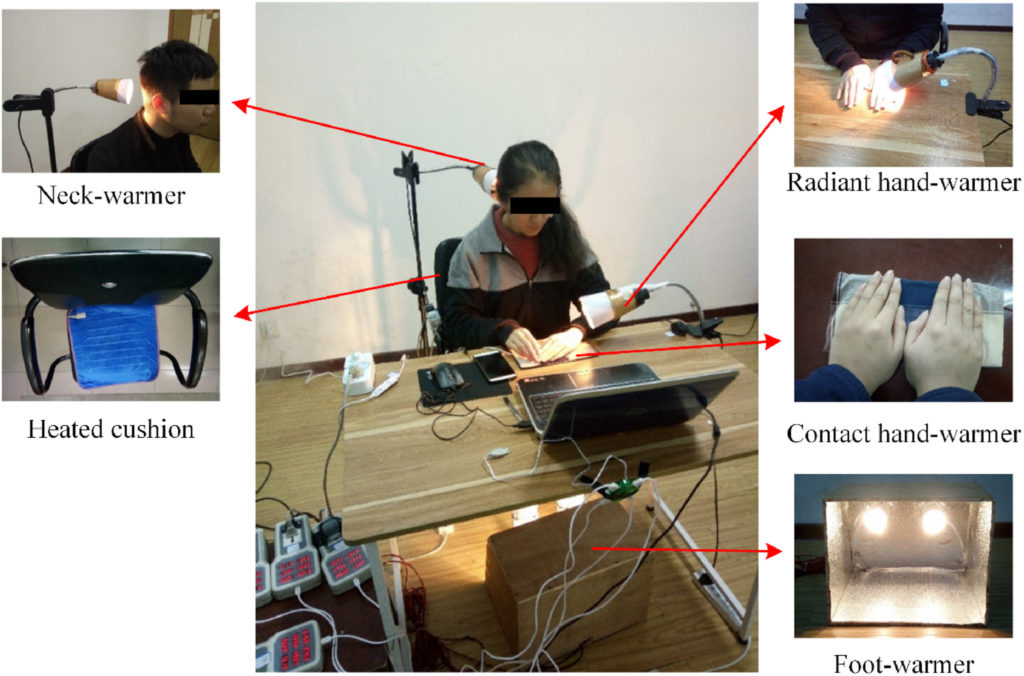
Source: https://www.sciencedirect.com/science/article/pii/S0360132321010337
Experiment Process
The experimental design included three modes of heating control: (1) adjustable room AC only, (2) adjustable AC together with adjustable PCS, and (3) adjustable PCS only. Each of the three control modes was tested under three starting room temperatures: 14 °C, 16 °C, and 18 °C. The PMV values for the room temperatures of 14 °C, 16 °C, and 18 °C are approximately ?2.0, ?1.5, and ?1.0 respectively [41]. The three PMV values were chosen for two reasons:
1) to detect the efficacy limit of PCS warming
2) to determine how much the intensity of resulting thermal pleasure depends on the cooling stimulus from the ambient environment on the whole-body.
The experiment was designed to compare the relative effectiveness of PCS and AC control in providing pleasure, and to test whether subjects’ control actions would differ for single versus combined control. Because subjects arrived at the experimental site with different thermal states from their mode of travel and the outdoor environment to which they were exposed, subjects sat in Room A at 20 °C for 20 min to neutralize their thermal state before starting the formal testing. After acclimation, subjects moved to Room B which was conditioned to one of the three starting ambient air temperatures (14 °C, 16 °C, and 18 °C). They were first exposed to the initial ambient air temperature for 10 min.
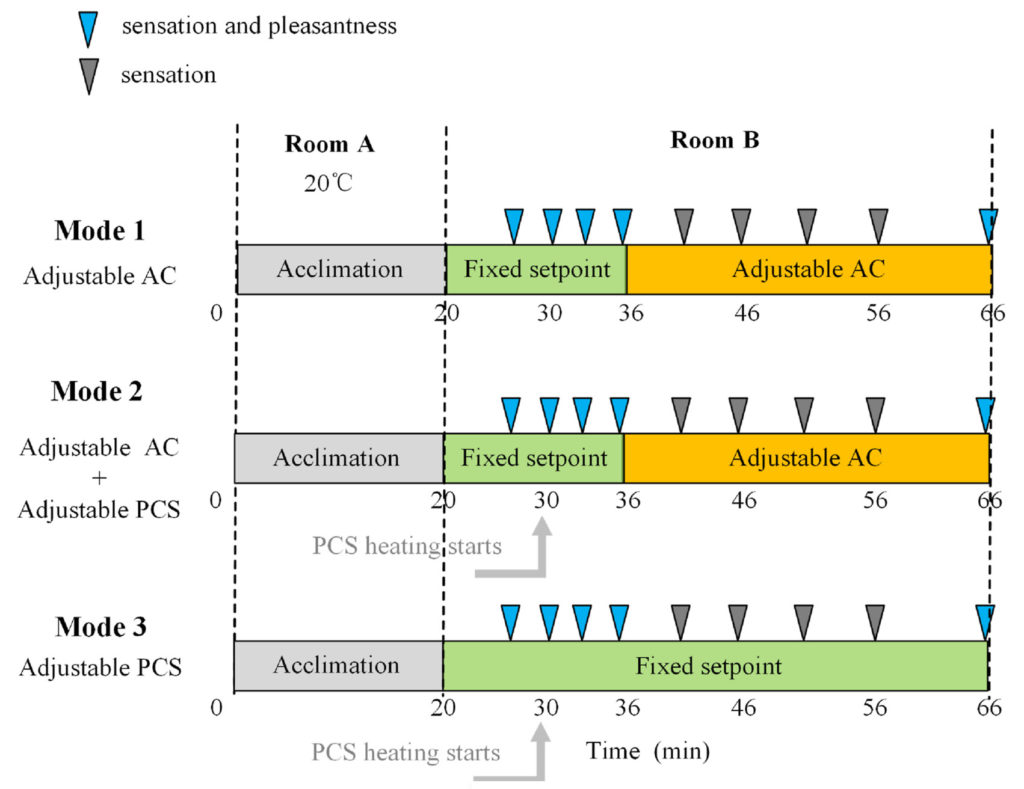
Source:https://www.sciencedirect.com/science/article/pii/S0360132321010337
The ambient air temperature was under the subjects’ control in Modes 1 and 2, but they were unaware of the AC setpoint temperature. After completing each survey, respondents were given the option to direct the researcher to immediately increase or reduce the temperature by an integer number, such as “no change” or “drop 2 °C.” The researcher would keep the existing interior temperature until the next survey point if the individuals made no requests for a change. Depending on the size of the intended adjustment, the maximum ambient air temperature change rate under AC-control was around 0.25 °C/min. In Modes 2 and 3, all five PCS devices were used at once but the participants were free to change their individual power settings.
It was anticipated that the PCS heating would have no discernible impact on the ambient temperature. For all testing, the relative humidity was around 50%. All test volunteers took part in every scenario, however they could only take one test per day. Testing took place from 9:30 to 12:00, 14:00 to 18:00, and 19:00 to 21:30. For each subject, the modes and starting temperatures were randomly chosen.
Measurement
Thermal pleasure was measured on a range from ‘very pleasant’ to ‘neutral’ to ‘very unpleasant’. Thermal pleasure votes were obtained both for whole-body pleasantness as well as for the four local heated sites (neck, hand, buttocks, and feet). The color scheme for the pleasantness scale reflected the application of heating to correct cool conditions.
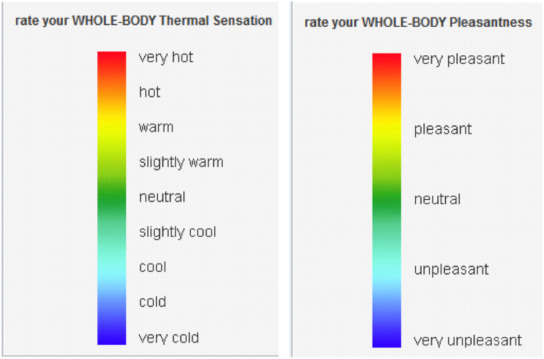
Results
The power of PCS to generate pleasurable reactions is highlighted by the three types of heating receiving the highest scores for both whole-body and local thermal pleasantness. Using PCS, group averages of whole-body pleasantness votes show the drastically different reactions to ambient heating (Modes 1 and 2) versus local heating (Mode 2 and Mode 3). Comparing Modes 1 and 2 reveals that using AC to raise the air’s temperature has a muted and slower effect on how you feel than using PCS to heat your body directly. The end rating was slightly over “neutral” for starting temperatures of 16 °C and 18 °C and at “neutral” for 14 °C starting temperature as a result of the room air warming in Mode 1 even when the air temperature is rising.
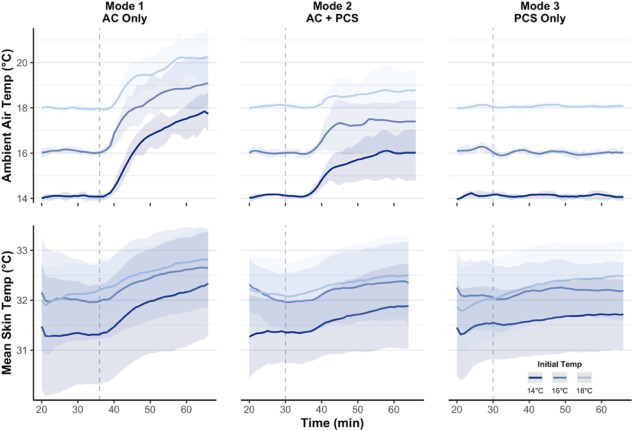
Source:https://www.sciencedirect.com/science/article/pii/S0360132321010337
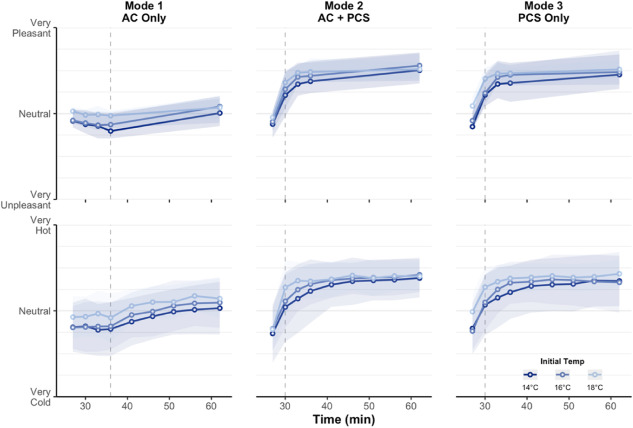
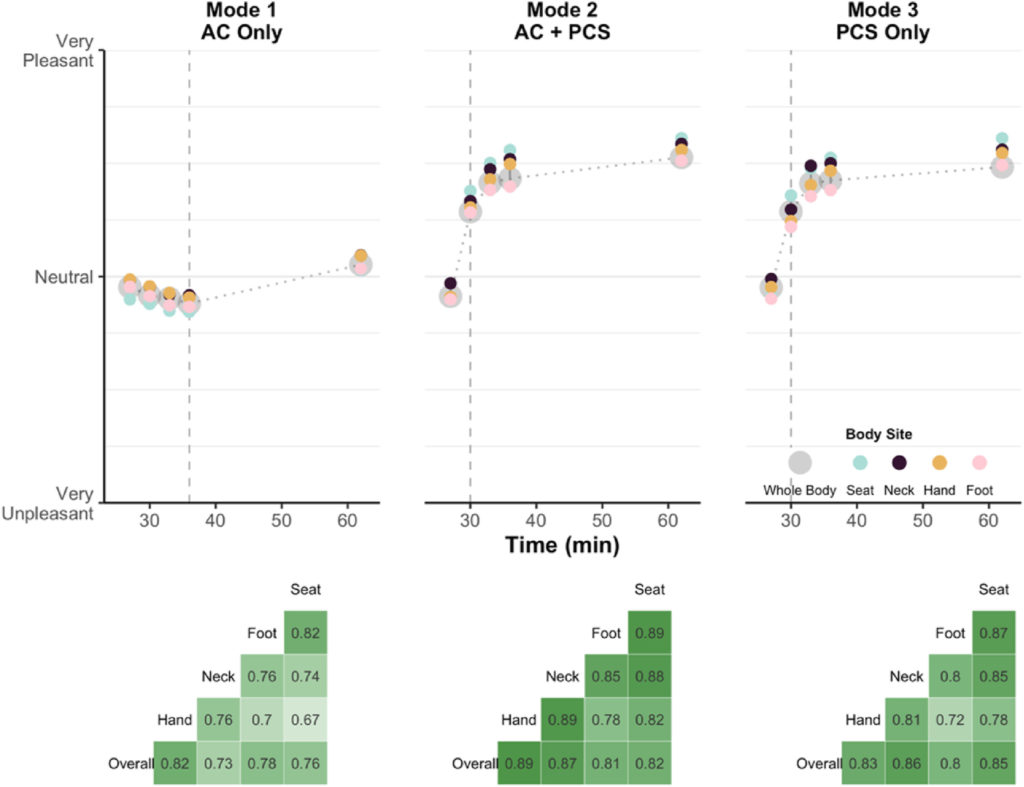
Conclusions of the experiment
Currently, HVAC systems are made to give occupants consistent, neutral interior conditions. Systems are specifically created to reduce local discomfort brought on by draft, a vertical temperature difference, asymmetric radiation, and surfaces that are either too warm or too cold. The moderate pleasure felt in Mode 1 shows that such circumstances are unlikely to offer the types of local skin temperature variations or transients necessary for eliciting thermal pleasure. There are principally two explanations for this: A room-sized environment must naturally warm up over time with AC, and uniform convective and radiant heating systems provide gradual increases in skin temperature. Contrarily, PCS enables rapid local skin temperature change by more effectively and powerfully directing heating energy into the person.
Experiment’s Teaching for Design
It is clear that static systems for conditioning the indoor environments give little to no pleasure to the occupants. Depending on the function of said indoor space the design could include systems that allow the occupant to control the thermal conditions of the indoor spaces. That generates positive feedback and perception of the space occupied and even more importantly the air conditioning doesn’t have to keep consuming energy in the effort of maintaining the same indoor temperature.
PROJECTS FROM THE PAST: Examples of Allesthesia in architecture
Shazdeh Garden, Iran

Source: https://www.tehrantimes.com/news/464486/UNESCO-designated-garden-reopens-after-two-month-closure-amid
Successful examples of dynamic environmental states, and consequently positive allesthesia, can be found in vernacular architecture.
An emblematic example is the Shazdeh Garden in Iran (Image above). The garden is an outstanding example of Persian gardens and it was built during the 18th century with the aim to resemble a version of Paradise on Earth.
In Persian “?????” means garden, but also paradise and there is an intrinsic reference to pleasure in the etymology of the word. The word “hedonistic” comes from the Greek h?don? (“pleasure”) and it is knowingly represented as a garden.
Rasoulian House, Yazd
The extensive research made by S. Asadi, M. Fakhari, M. Sendi and published on 1st September of 2016 called : “ A study on the thermal behavior of traditional residential buildings: Rasoulian house case study” shows us the mastery in thermal properties manipulation.


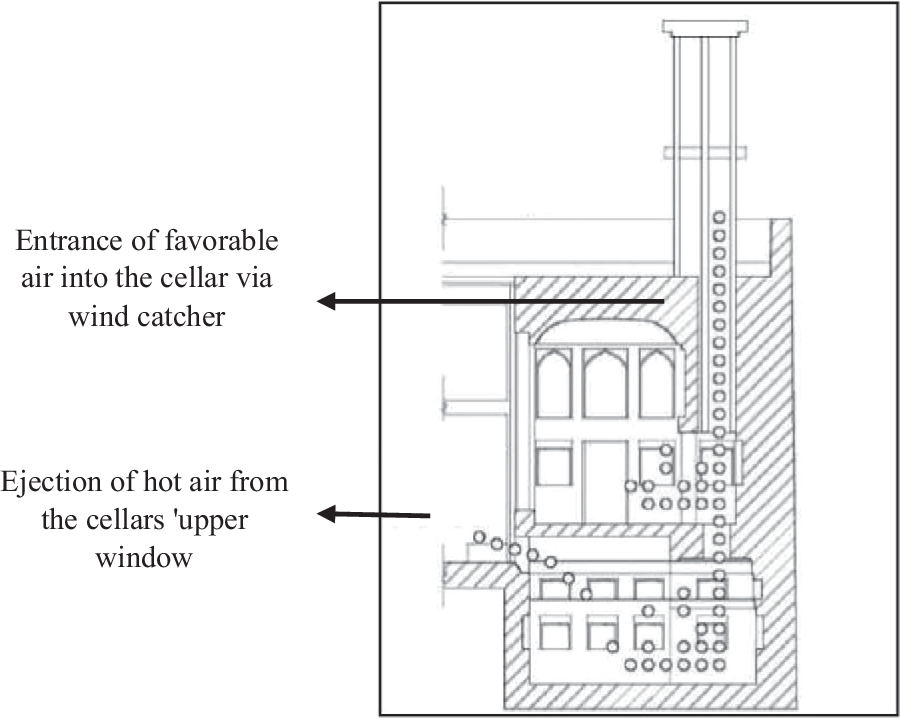
The house revolves around two courtyards. A public one for guests, it has a big pool in the center and it is characterized by greenery and colorful windows and a private one for inhabitants, especially the women in the house. The other rooms revolve around these courtyards. Service Spaces are located underground and a windcatcher rises from the house block.
The windcatcher carries air in the underground cellar where it becomes colder and mitigates temperature on ground floor while ejecting higher hot air.
You can see from the research results how with no mechanical conditioning the resulting average temperature of the analyzed zones is comfortable and constant while the outdoor temperature rises up and down. The project’s expedients as wind catching, thick walls, orientation, water and greenery are all very effective strategies with little to none carbon footprint.
Sarabhai House, India
“From the cool moments of the early morning through the furnace of afternoon heat, and into slow cooling of the evening and dark relief of the night, the house is an active participant in the daily rituals of its inhabitants”
From: The Dance of a Summer Day , M. Susan Ubbelohde
In this project LeCorbusier manages to create a building that is capable to resist the harshness of very hot summer days in India while enjoying the spaces and create different perceptive experiences of the indoor and outdoor environments.
“The Sarabhai house performs an especially elegant dance with these realities of summer living: dawn-awakening to the world; afternoon – a protective refuge from the oppressive heat; dusk – opening to the slow cooling of the garden; night – cool terraces and roofs under the moonlight and stars.“
The human experience of temperature, tactile, visual, and auditory sensations, shifting spatial and temporal order, and tectonic formation all contribute to the dance of the house.
Over the course of a summer day, the house develops our notion of public and private, inside and out, rest and activity, and finally transforms it., “the cave and the pavilion”.
“Though modern in terms of form, the house recapitulates this daily traditional performance from late March until the rains arrive in June”
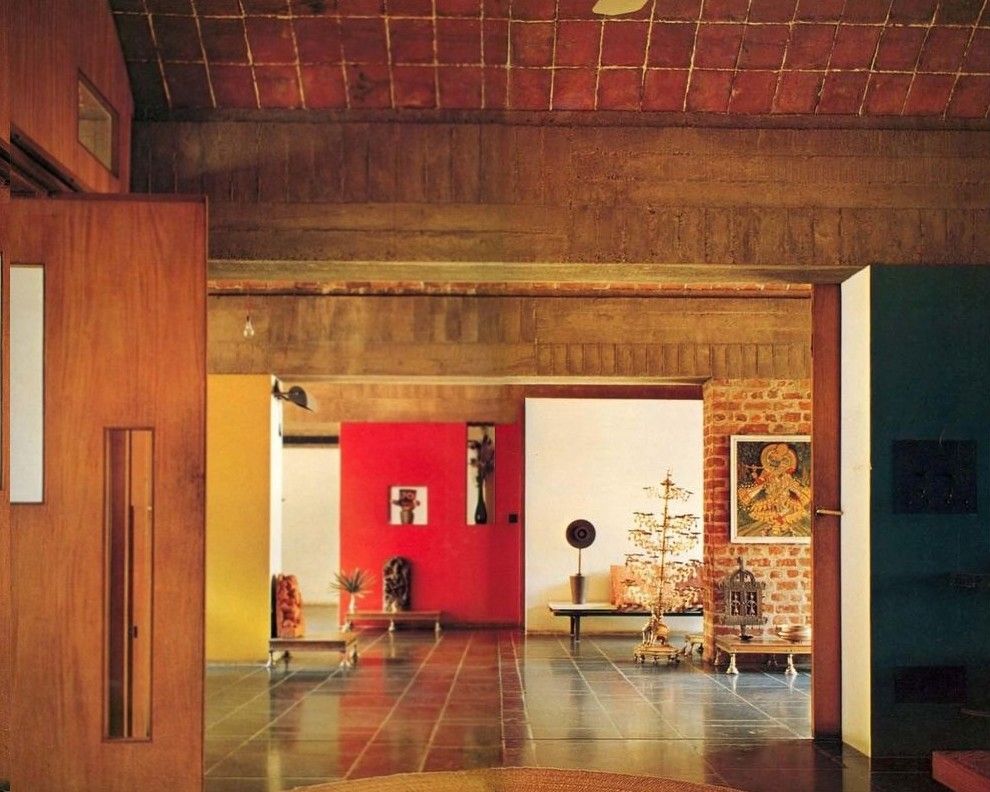
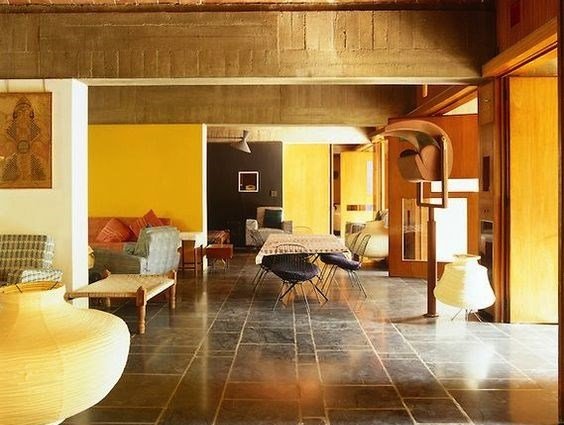
Source:https://www.pinterest.com/pin/440367669791570570/
Lumen, New York
“Lumen is knitted light, bathing visitors in a responsive glow of photo-luminescence; by day”
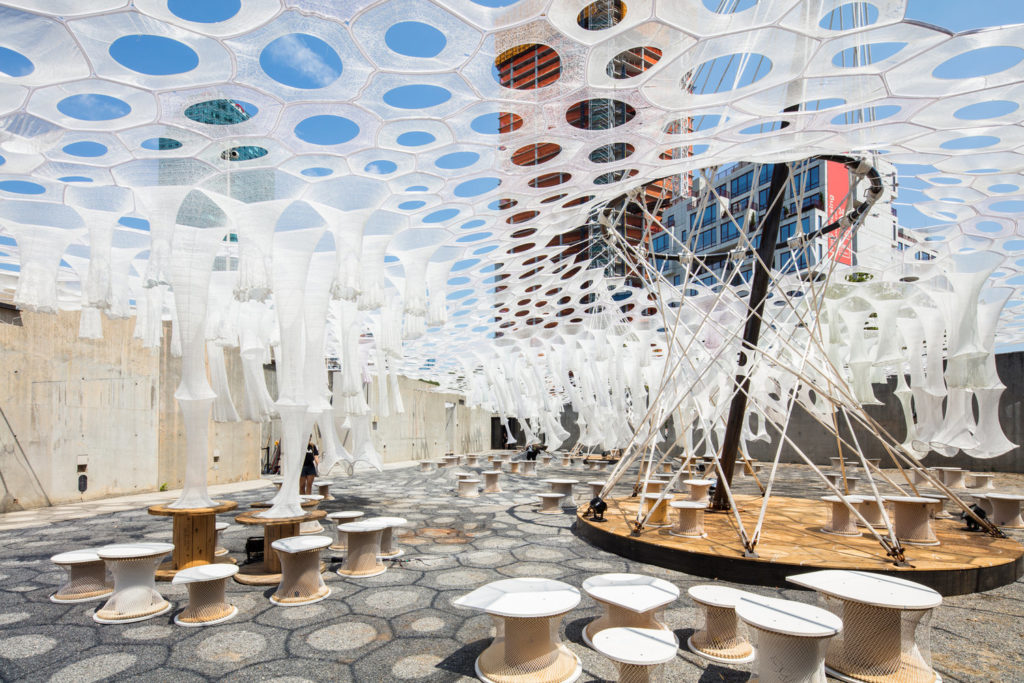
This original project aim to be a responsive structure to climate conditions. It is a lightweight knitted fabric of responsive tubular structures and a canopy of cellular components employs recycled textiles, photo-luminescent and solar active yarns that absorb, collect, and deliver light. This environment offers spaces of respite, exchange, and engagement as a misting system responds to visitors’ proximity, activating fabric stalactites that produce a refreshing micro-climate. Families of robotically woven recycled spool chairs reveal informal messages and conversations through hydro-chromic materials. It is an open responsive system featuring digitally knitted and robotically woven lightweight, high-performing, formfitting, and adaptive materials. Lumen is a feminine form that offers luminous interiorities, informal networks, social fabrics, and fibrous assemblages that are pliable, transformative, and playful.
In the following image we can see how modern tools are implied to reach this design result.
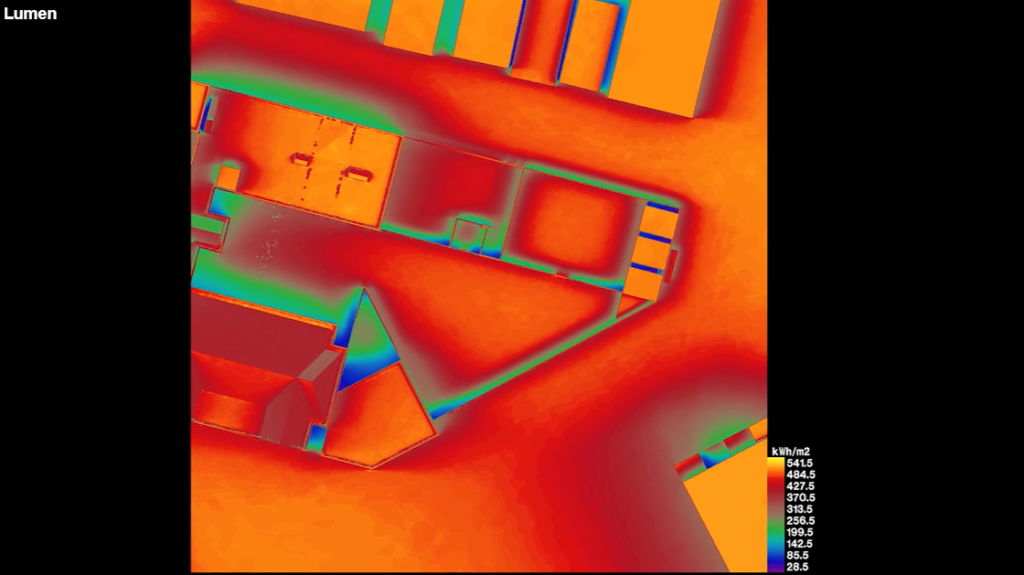
Source: https://www.jennysabin.com/lumen
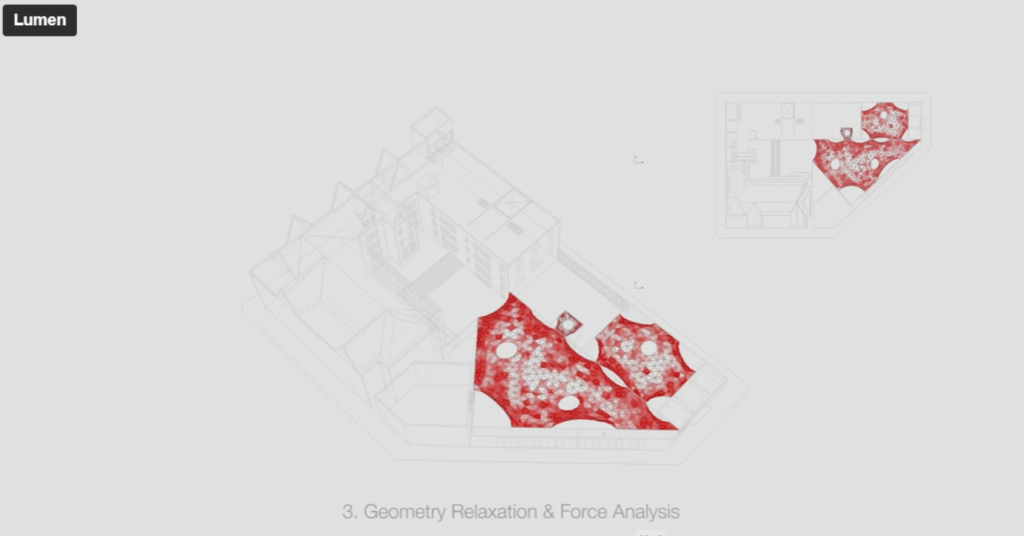
Source: https://www.jennysabin.com/lumen
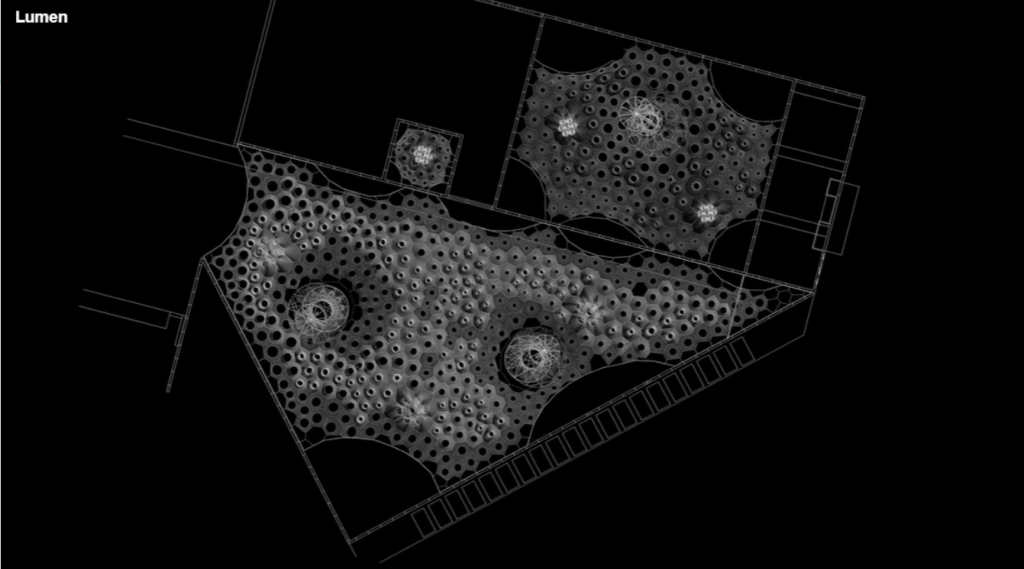
Source: https://www.jennysabin.com/lumen
“Through direct references to the flexibility and sensitivity of the human body, Lumen integrates adaptive materials and architecture where code, pattern, human interaction, environment, geometry and matter operate together as a conceptual design space. Knitting and textile fabrication offer a fruitful material ground for exploring these nonstandard fibrous potentials. As with cell networks, materials find their own form where the flow of tension forces through both geometry and matter serve as active design parameters. Lumen undertakes rigorous interdisciplinary experimentation to produce a multisensory environment that is full of delight, inspiring collective levity, play, and interaction as the structure and materials transform throughout the day and night”
Outcomes and Future Vision
A recent study by [Presti, P., Ruzzon, D., Avanzini, P. et al. Measuring arousal and valence generated by the dynamic experience of architectural forms in virtual environments. Sci Rep 12, 13376 (2022). https://doi.org/10.1038/s41598-022-17689-9] showcased how modern computational tools can be utilized to reform psychological outcomes for the individuals regarding architectural space. The built environment has a significant impact on how people feel about themselves. Researchers recently measured subjective assessments of perceived valence (pleasantness) and arousal in response to the dynamic experience of a gradual shift in the macro visuospatial dimensions of virtual places to examine the effect of architectural design on emotions. The researchers created a parametric model that made it possible to generate 54 virtual architectural designs with varying sidewall distances, window and ceiling heights, and ambient colors. The findings demonstrated a considerable impact on the emotional state of participants within the virtual surroundings, resulting in high arousing and unpleasant moods when sidewall distance decreased, ceiling height variation increased, and windows height increased.
This study emphasizes the significance of dynamic virtual environment experiences in assessing the emotional impact of large-scale architectural aspects. High ceilings, open areas, and windows are typically connected to pleasant feelings, while cold colors typically receive higher valence ratings than warm ones. Previous research using static 2D representations had already demonstrated that various architectural features significantly influence affective states. The quantity of light that enters a room through windows and the usage of warm or cool colors may both influence how arousal levels are felt. High levels of tension and arousal have been associated with enclosed areas and low ceilings, respectively.
Virtual reality technologies, such as head-mounted displays (HMDs), have gained increasing importance in creating immersive and realistic architectural experiences. HMDs provide a subjective camera that follows head movement, updating sensory perception in real-time and creating a place illusion that generates realistic affective and behavioral responses in people. Compared to 2D stimuli, immersive virtual reality enhances spatial perception and can generate neurophysiological responses similar to those of real-world scenarios.
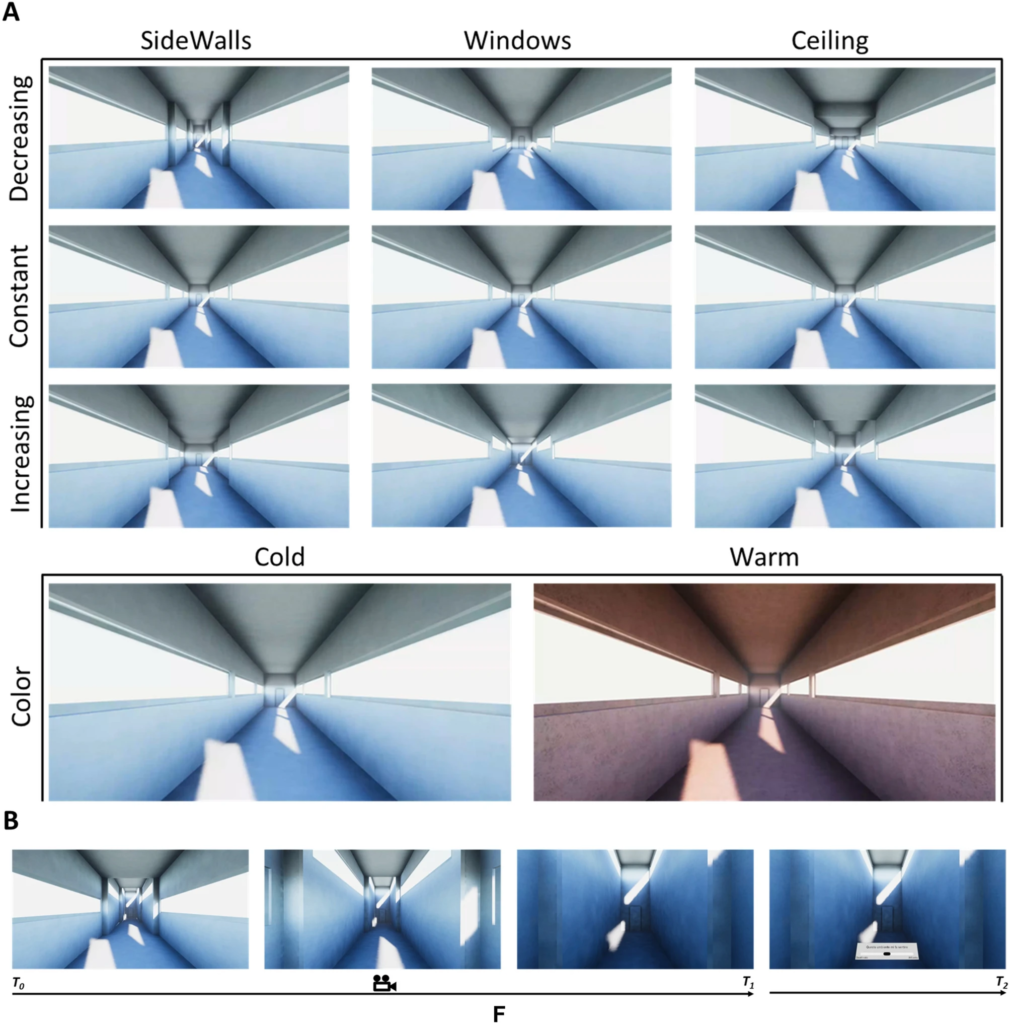
Source:https://www.nature.com/articles/s41598-022-17689-9
The results of this study serve as a basis for further investigation into the impact of architectural design—a key element in the development of new spaces—on mental states. Designing environments that encourage wellbeing and improve people’s overall quality of life can be influenced by knowledge of how the built environment impacts emotions. When researching the emotive effects of architectural design, it is crucial to take into account the dynamic experience of virtual settings. Research into this topic and the connection between the built environment and affective states should continue.
To conclude it is clear, how people’s emotive states are influenced by the dynamic experience of architectural design’s macro-spatial fluctuations. Anguish-inducing feelings were produced by the visuospatial exploration of those situations, which were distinguished by a steady shrinkage of the extra-personal space. A more broadly applicable understanding of architectural perception will be advanced by extending the suggested experimental framework to examine physiological responses to architectural alterations. The current results may thus open the door for future research examining how the architectural experience affects a person’s behavior and psychophysiology in social circumstances.
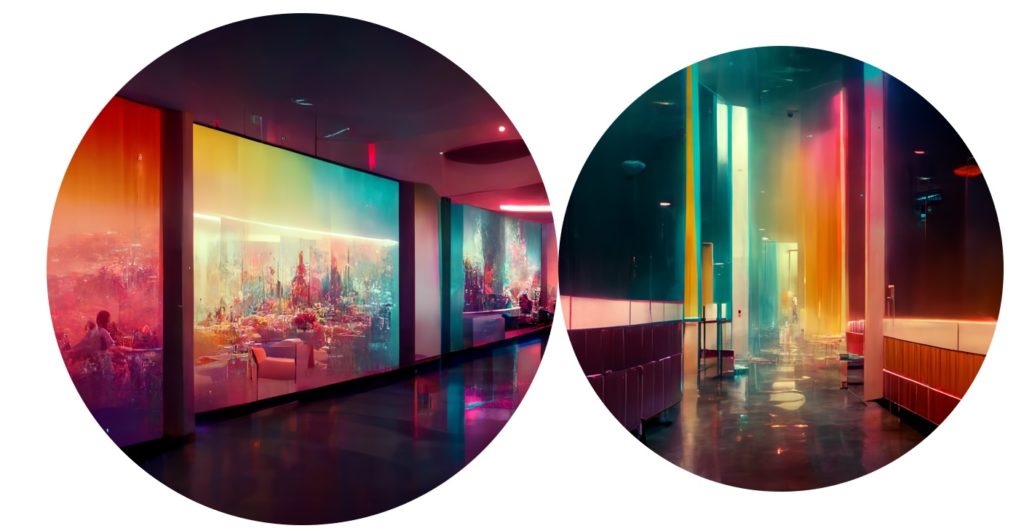
Source: https://cdn.midjourney.com/82a80ae6-9281-45db-a109-fff645a789a6/grid_0.png, https://cdn.midjourney.com/d59bb77f-ce70-48c1-bac5-4ec8f9a27b74/grid_0.png
Bibliography
- Presti, P., Ruzzon, D., Avanzini, P. et al., Measuring arousal and valence generated by the dynamic experience of architectural forms in virtual environments. Sci Rep 12, 13376, https://doi.org/10.1038/s41598-022-17689-9, 2022.
- Barbosa Escobar F, Velasco C, Motoki K, Byrne DV, Wang QJ, The temperature of emotions, https://doi.org/10.1371/journal.pone.0252408, 2021.
- Juhani Pallasmaa, The Eyes of the Skin: Architecture and the Senses, 1996.
- Theodore K. Yanagihara, The Dissociation of Valence and Intensity Using Alliesthesia and Thermal Stimulation, 2012.
- Yingdong He, Thomas Parkinson, Edward Arens, Hui Zhang, Nianping Li, Jinqing Peng, John Elson, Clay Maranville, Creating alliesthesia in cool environments using personal comfort systems, https://doi.org/10.1016/j.buildenv.2021.108642, 2022.
- S. Asadi, M. Fakhari, M. Sendi, A study on the thermal behavior of traditional residential buildings:Rasoulian house case study, https://doi.org/10.1016/j.jobe.2016.07.012, 2016.
- M. Susan Ubbelohde, The Dance of a Summer Day, 2003.
- Jenny Sabin, Lumen, https://www.jennysabin.com/lumen, 2017.
- Hall, Edward T. , The hidden dimension, 1966.
- Midjourney AI, Vision of Alliesthesia Prompt Variants by Lora Fahmy and Georgios Bekakos , https://www.midjourney.com/app/, 2022.
- Winkielman, P., Berridge, K. C., & Wilbarger, J. L., Unconscious Affective Reactions to Masked Happy Versus Angry Faces Influence Consumption Behavior and Judgments of Value. Personality and Social Psychology Bulletin, 31(1), 121–135., https://doi.org/10.1177/0146167204271309, 2005.

